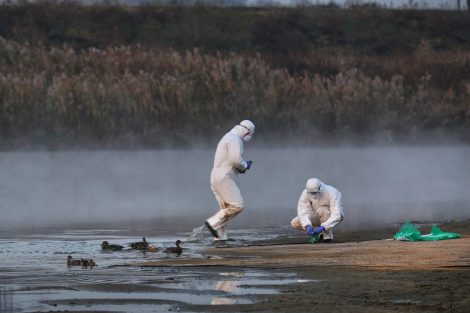Biological threat reduction

Strengthening Global Biological Security
Infectious disease agents and toxins found in animal populations and animal products are a considerable and on-going threat to animal health, agricultural economies, food security (both crops and livestock), food safety, and public health.
By and large most disease outbreaks and food contaminations occur naturally. However, there is also a real risk that disease may be introduced into susceptible human or animal populations following a deliberate or accidental release of an infectious agent or toxin. These ‘unnatural’ biological threats carry special risks because pathogens may be engineered or released in such a way as to make them more harmful. Although the probability of a deliberate or accidental release may be relatively low the impact may be catastrophic from a national to a global level.
Animal pathogens may be used as bioweapons or in bioterror because they have a high impact, are cheap, easy to acquire and propagate, and can be readily smuggled through border checks undetected. The biotechnology revolution means that options for engineering animal pathogens are increasing all of the time whilst the cost of doing so is decreasing. All of the animal pathogens that have been developed as bioweapons or have potential for use as such are listed by the World Organisation for Animal Health.
Animals themselves play an important role as biosensors for accidental or deliberate releases of infectious agents and toxins, and for emerging diseases. The same disease surveillance and intelligence systems that are in place to detect day-to-day occurrences of natural outbreaks, within countries and at national borders, will also detect deliberate and accidental releases.
The response to disease is the same whether it is directed against natural infection, or deliberate or accidental release. In the case of zoonotic diseases, coordination of the animal health and public health response is essential, and control is often best focused on eliminating the pathogen in the animal source. Expert investigations carried out by health authorities are needed to establish the cause of a disease outbreak and Veterinary Laboratories are often the first to discover the source. When there is suspicion of malicious release, collaboration with law enforcement agencies becomes an important part of the response.
The most effective and sustainable way to protect against threats from deliberate and accidental releases of animal pathogens is to strengthen existing systems for surveillance, early on-farm detection and rapid response, and for biosafety and biosecurity, whilst fostering scientific networks that work towards altruistic goals. This approach has multiple collateral benefits for animal health, agriculture, public health, poverty alleviation, animal welfare, and economies.
Biological Threat Reduction Strategy
In meeting its mandate to improve animal health, veterinary public health, and animal welfare worldwide, WOAH takes the threat posed by accidental and deliberate release of animal pathogens very seriously. WOAH’s strategy for bio-threat reduction, which is summarised in this paper, focuses on strengthening, enhancing, and developing cross-links between existing health systems.
This strategy is consistent with and supported by WOAH’s Fifth Strategic Plan (2011-2015) and cuts across all of its six objectives, namely international communication of global animal disease and zoonosis situation; development and implementation of science-based standards and guidelines on prevention, control and eradication of animal diseases, including zoonoses, and safety of international trade of animals and animal products as well as laboratory excellence; ensuring the scientific excellence of information and advice; capacity-building for national Veterinary Services, including their surveillance and response capacities; and strengthening the organisation’s influence on policy design, applied research and governance.
The strategy for bio-threat reduction addresses 5 key areas:
- Policies, advocacy, and communication
- Maintaining expertise and setting standards, guidelines, and recommendations
- International cooperation
- Global disease intelligence
- Capacity-building and solidarity
Resources
-
Guidelines for responsible conduct in veterinary research
-
Bridging Epidemiology and Forensics
-
Guidelines for Investigation of Suspicious Biological Events
-
Consultation on Sustainable Laboratories
-
Guidance on biosafety and biosecurity in veterinary laboratories and animal facilities
-
Rinderpest post-eradication
-
Biological and Toxin Weapons Convention
-
Statement at 7th Review Conference of the BWC
-
Canada’s Weapons Threat Reduction Program
